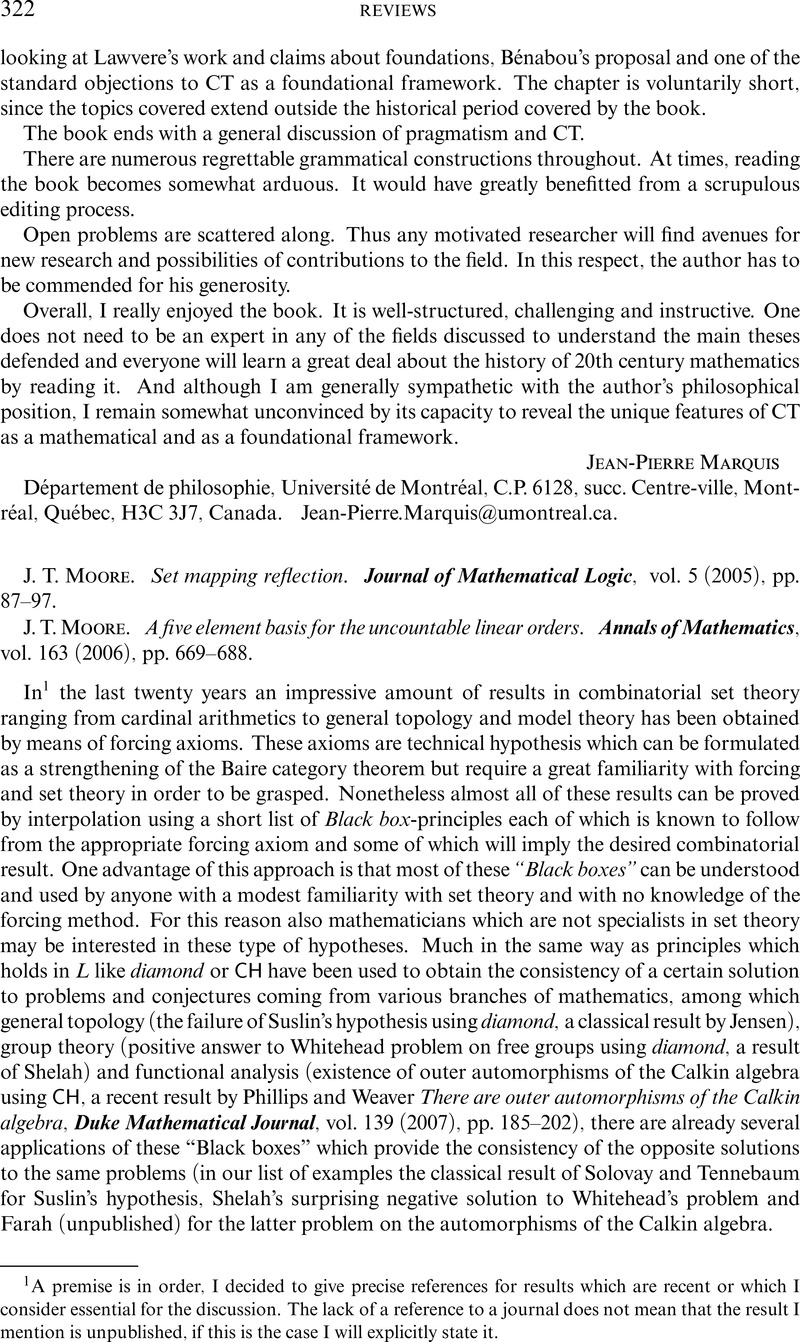Article contents
J. T. Moore. Set mapping reflection. Journal of Mathematical Logic, vol. 5 (2005), pp. 87–97. - J. T. Moore. A five element basis for the uncountable linear orders. Annals of Mathematics, vol. 163 (2006), pp. 669–688.
Review products
Published online by Cambridge University Press: 15 January 2014
Abstract

Information
- Type
- Reviews
- Information
- Copyright
- Copyright © Association for Symbolic Logic 2009
References
1 A premise is in order, I decided to give precise references for results which are recent or which I consider essential for the discussion. The lack of a reference to a journal does not mean that the result I mention is unpublished, if this is the case I will explicitly state it.
2 This conjecture asserts that there are five uncountablee linear orders such that any other uncountable linear order contains an isomorphic copy of one of these five. This proof has been later refined by König, , Moore, , Larson, and Veličković, in Bounding the consistency strength of a five element linear basis, Israel Journal of Mathematics, vol. 164, (2008), pp. 1–18 CrossRefGoogle Scholar, reducing the large cardinal strength of the assumptions needed to obtain the consistency of the conjecture to a very weak large cardinal hypothesis (the existence of a Mahlo cardinal suffices).
3 Subsequently Caicedo and Velickovic refined this result and showed that MRP (or BPFA) implies that there is a Δ1-definable well ordering of ℝ in the structure H (ℵ2)(see Bounded proper forcing axiom and well orderings of the reals, Mathematical Research Letters, vol. 13 (2006), pp. 393–408 CrossRefGoogle Scholar).
4 SCH holds if κcf(κ) = 2cf(κ) + κ+ for all singular cardinals κ.
5 {M ξ : ξ < λ} is a continuous ∈-chain if {M ξ : ξ ≤ η} ∈ M η+1 and ∪ξ<η M ξ = M η for all η < λ.
6 See Generic absoluteness and the continuum, Mathematical Research Letters, vol. 9 (2002), pp. 465–471 CrossRefGoogle Scholar.
7 Eisworth, and Nyikos, in First countable, countably compact spaces and the Continuum Hypothesis, Transactions of the American Mathematical Society, vol. 357 (2005), pp. 4329–4347 CrossRefGoogle Scholar, introduce and analyze the class of weakly ω-proper posets.
8 For example the Black box-principles PID and OCA can be forced by weakly ω-proper posets.
9 (C δ : δ < ω1) is a weak club guessing sequence if C δ has type ω for all limit δ and for every C club subset of ω1 there is a δ such that C δ ∩ C is infinite. (C δ : δ < ω1) is a club guessing sequence if for all clubs C there is a δ such that C δ ⊆ C.
10
(C
δ : δ < ω1) is a ![]() -sequence if C
δ is cofinal in δ of type ω for all limit ordinals δ.
-sequence if C
δ is cofinal in δ of type ω for all limit ordinals δ.
11
Given a ![]() -sequence apply MRP to the mapping Σ
-sequence apply MRP to the mapping Σ
![]() (M) = [δ]ℵ0
⃥ C
δ where δ = M ∩ ω1 and M ≺ H (ℵ2) is a countable model such that
(M) = [δ]ℵ0
⃥ C
δ where δ = M ∩ ω1 and M ≺ H (ℵ2) is a countable model such that ![]() ∈ M.
∈ M.
12 Moore can refine this argument also to the case of weakly ω-proper posets.
13 An introduction to this work of Woodin can be found in his expository articles The continuum hypothesis, I, Notices of the American Mathematical Society, vol. 48, pp. 567–576 Google Scholar and The continuum hypothesis, II, Notices of the American Mathematical Society, vol. 48, pp. 681–690 Google Scholar.
14 Notice that ¬CH is a Π2-sentence.
15
For α a limit ordinal, ![]() is the set of boolean valued terms in
is the set of boolean valued terms in ![]() of rank less than α. In order to avoid complications in the definition of
of rank less than α. In order to avoid complications in the definition of ![]() only boolean valued models of the type
only boolean valued models of the type ![]() with α a limit ordinal can be considered. This does not cause any loss of generality in the definition of Ω-truth.
with α a limit ordinal can be considered. This does not cause any loss of generality in the definition of Ω-truth.
16 Nonetheless this has been shown by Larson, in Martin's Maximum and the ℙmax axiom (*), Annals of Pure and Applied Logic, vol. 106 (2000), pp. 135–149 CrossRefGoogle Scholar.
- 1
- Cited by

